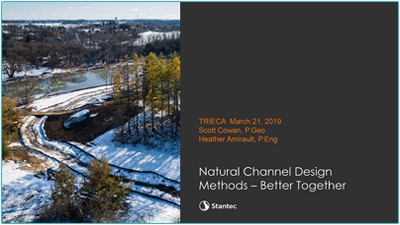TRACK 2
Natural Channel Design Methods: Better Together
ABSTRACT
Stream rehabilitation design is a complex task. There has historically been debate among stream rehabilitation practitioners about the “best” method to apply for stream rehabilitation design.
While the number and variety of methods available is extensive, two approaches are arguably the most common:
- The analogue (or reference-reach) approach, which applies dimensionless expressions of quasi-equilibrium river morphology to guide design parameters.
- The deterministic (or analytical) approach, which employs first principles of physics and hydraulics, through hydraulic modelling, to guide morphology for a quasi-equilibrium design.
In stream rehabilitation design, both approaches are valid. But neither is infallible — and each approach, on its own, could result in flawed designs.
This presentation advocates that these two methods should be seen as complementary approaches, rather than competing.
The example presented here shows that without the inputs from a 2D model, a design solely based on reference reach methods may have failed due to underestimated floodplain shear stress
Conversely, using an analytical approach and no reference reach may have resulted in the design not meeting its habitat and long-term stability objectives.
Accordingly, a robust, quasi-equilibrium stream rehabilitation design should rely on both analogue and deterministic approaches.
Learning Objectives
1. Gain an understanding of the strengths and weaknesses of the analogue (reference reach) design approach for natural channel design
2. Gain an understanding of the strengths and weaknesses of the deterministic (analytical) design approach for natural channel design
3. Gain an understanding of how 2D modelling can improve natural channel designs
ABOUT THE PRESENTERS

Heather Amirault
Heather Amirault is a water resources engineer at Stantec Consulting Ltd. She specializes in the areas of stream rehabilitation using natural channel design and geomorphic assessment.
Heather’s recent projects include the removal of two dams on Idlewood Creek for fish passage in Kitchener, ON, and the restoration of Kokanee spawning areas after a large flood in Kelowna, BC.
Heather has worked on stream restoration and assessment projects across Canada and in the US.

Scott Cowan
Scott Cowan is a fluvial geomorphologist at Stantec Consulting Ltd., specializing in the practical application of fluvial geomorphology including natural channel design, geomorphic baseline assessment and riverine hazard assessment.
Scott has worked on stream assessment and restoration design projects in a variety of environments across Canada.

